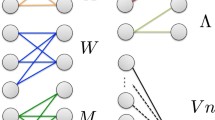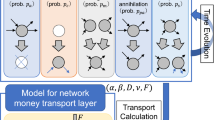Abstract
Symmetry of the world trade network provides a novel perspective to understand the world-wide trading system. However, symmetry in the world trade network (WTN) has been rarely studied so far. In this paper, the authors systematically explore the symmetry in WTN. The authors construct WTN in 2005 and explore the size and structure of its automorphism group, through which the authors find that WTN is symmetric, particularly, locally symmetric to a certain degree. Furthermore, the authors work out the symmetric motifs of WTN and investigate the structure and function of the symmetric motifs, coming to the conclusion that local symmetry will have great effect on the stability of the WTN and that continuous symmetry-breakings will generate complexity and diversity of the trade network. Finally, utilizing the local symmetry of the network, the authors work out the quotient of WTN, which is the structural skeleton dominating stability and evolution of WTN.
Similar content being viewed by others
References
H. Weyl, Symmetry, Princeton University Press, Princeton, N. J., 1952.
E. P. Wigner, Symmetries and Reflections: Scientific Essays, MIT Press, Cambridge, MA, 1970.
A. Zee, Fearful Symmetry: The Search for Beauty in Modern Physics, Princeton Univ Press, Princeton, 1999.
K. Mainzer, Symmetry and Complexity: The Spirit and Beauty of Nonlinear Science, World Scientific, Singapore, 2005.
M. Golubitsky and I. Stewart, The Symmetry Perspective, Progress in Mathematics, Birkhauser Verlag, Basel, 2002.
G. Xu, J. Gu, and H. Che, System Science (in Chinese), Shanghai Scientific and Technological Education Publishing House, Shanghai, 2000.
R. Albert and A. L. Barabási, Statistical mechanics of complex networks, Rev. Modern Phys., 2002, 74(1): 47–97.
R. Albert, H. Jeong, and A. L. Barabási, Internet: Diameter of the world-wide web, Nature, 1999, 401: 130–131.
L. A. N. Amaral, A. Scala, M. Barthélémy, and H. E. Stanley, Classes of small-world networks, in Proc. Natl. Acad. Sci. USA, 2000, 97(21): 11149–11152.
A. L. Barabási and R. Albert, Emergence of scaling in random networks, Science, 1999, 286(5439): 509–512.
P. J. Cameron, Permutation Groups (London Mathematical Society Student Texts), vol. 45, Cambridge University Press, Cambridge, 1999.
A. H. Dekker and B. Colbert, The symmetry ratio of a network, in Proceedings of the 2005 Australasian Symposium on Theory of Computing, 2005: 13–20.
W. Dicks and M. J. Dunwoody, Groups Acting on Graphs, Cambridge Studies in Advanced Mathematics, vol. 17, Cambridge University Press, Cambridge, 1989.
P. Holme, Detecting degree symmetries in networks, Phys. Rev. E, 2006, 74(3): 036107.
J. Lauri and R. Scapellato, Topics in Graph Automorphisms and Reconstruction, London Mathematical Society Student Texts, vol. 54, Cambridge University Press, Cambridge, 2003.
B. D. MacArthur and James W. Anderson, Symmetry and self-organization in complex systems, 2006. ArXiv: cond-mat/0609274 v1.
B. D. MacArthur, R. J. Sánchez-García, and J. W. Anderson, Symmetry in complex networks, Discrete Applied Mathematics, 2008, 156(18): 3525–3531.
F. R. K. Chung, Spectral Graph Theory, American Mathematical Society, Washington, DC, 1997.
L. H. Soicher, Computing with Graphs and Groups, in Topics in Algebraic Graph Theory (ed. by L. W. Beineke and R. J. Wilson), Cambridge University Press, Cambridge, 2004.
W. Kocay, Groups & Graphs, a Macintosh application for graph theory, J. Combin. Math. Combin. Comput., 1988, 3: 195–206.
B. Bollobas, Random Graphs, Seconded, Cambridge Studies in Advanced Mathematics, vol. 73, Cambridge University Press, Cambridge, 2001.
M. A. Serrano and M. Boguñá, Topology of the world trade web, Physical Review E, 2003, 68(1): 015101(R).
D. Garlaschelli and M. Loffredo, Fitness-dependent topological properties of the world trade web, Physical Review Letters, 2004, 93(18): 188701.
D. Garlaschelli and M. Loffredo, Structure and evolution of the world trade network, Physical A, 2005, 355(1): 138–144.
X. Li, Y. Y. Jin, and G. Chen, Complexity and synchronization of the world trade web, Physical A, 2003, 328: 287–296.
G. Fagiolo, J. Reyes, and S. Schiavo, On the topological properties of the world trade web: A weighted network analysis, Physical A, 2008, 387(15): 3868–3873.
V. Batagelj and A. Mrvar, Pajek-program for large network analysis, Connections, 1998, 21: 47–57.
Import/Export databases are publicly available at the address: http://www.intracen.org/menus/countries.htm.
B. D. McKay, Practical graph isomorphism, Congr. Numer., 1981, 30: 45–87.
J. Lauri and R. Scapellato, Topics in Graph Automorphisms and Reconstruction, London Mathematical Society Student Texts, vol. 54, Cambridge University Press, Cambridge, 2003.
Y. Xiao, M. Xiong, W. Wang, and H. Wang, Emergence of Symmetry in Complex Networks, Physical Review E, 2008, 77(6): 066108.1–066108.10.
Y. Xiao, B. D. MacArthur, H. Wang, M. Xiong, and W. Wang, Quotient networks: Structural skeletons of complex systems, Physical Review E, 2008, 78(4): 046102.1–046102.7.
Y. H. Xiao, W. T. Wu, H. Wang, M. Xiong, and W. Wang, Symmetry-based structure entropy of complex networks, Physical A, 2008, 387: 2611–2619.
M. Klin, Ch. Rcker, G. Rcker, and G. Tinhofer, Algebraic Combinatorics in Mathematical Chemistry, Methods and Algorithms, I. Permutation Groups and Coherent (Cellular) Algebras, Technische Universiät München, München, 1995.
Author information
Authors and Affiliations
Corresponding author
Additional information
This research was supported by the National Natural Science Foundation of China under Grant No. 70371070; Shanghai Leading Academic Discipline Project under Grant No. S30504; and Key Project for Fundamental Research of STCSM under Grant No. 06JC14057.
Rights and permissions
About this article
Cite this article
Wang, H., Yan, G. & Xiao, Y. Symmetry in world trade network. J Syst Sci Complex 22, 280–290 (2009). https://doi.org/10.1007/s11424-009-9163-9
Received:
Revised:
Published:
Issue Date:
DOI: https://doi.org/10.1007/s11424-009-9163-9




